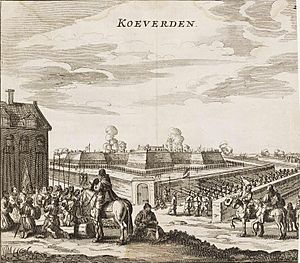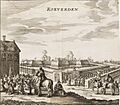Siege of Coevorden (1592) facts for kids
Quick facts for kids Siege of Coevorden 1592 |
|||||||
|---|---|---|---|---|---|---|---|
| Part of the Eighty Years' War & the Anglo–Spanish War | |||||||
 Siege of Coevorden,1592, print by Johannes Janssonius |
|||||||
|
|||||||
| Belligerents | |||||||
German Mercenaries |
|||||||
| Commanders and leaders | |||||||
| Strength | |||||||
| 8,000 | 1,900 5,000 (relief) |
||||||
| Casualties and losses | |||||||
| Unknown | 1,400 killed, wounded or from disease, 500 surrendered |
||||||
The Siege of Coevorden was an important battle that happened between July 26 and September 2, 1592. It was part of two bigger conflicts: the Eighty Years' War and the Anglo–Spanish War. During this time, the city of Coevorden in the Netherlands was attacked.
A combined army of Dutch and English soldiers led by Maurice of Orange surrounded the city. Inside Coevorden, the Spanish forces were commanded by Frederik van den Bergh. He was put in charge by King Philip II of Spain.
Later, a Spanish army tried to help the trapped soldiers in Coevorden. This relief force was led by Francisco Verdugo and Cristóbal de Mondragón. However, their attempt to break the siege failed. Many of their soldiers also left or got sick. Because of this, the Spanish relief force had to retreat. This left Coevorden on its own. On September 2, 1592, the soldiers defending Coevorden surrendered. This was a big victory for the Dutch and English.
Contents
Why Coevorden Was Important
In 1591, Maurice of Orange, who was the main military leader for the Dutch Republic, had a very successful year. He captured several important cities. One of his biggest wins was taking Nijmegen in October 1591. He also captured Delfzijl. This meant that Groningen, a major city in the region of Drenthe, lost its main port for trade.
Maurice's main goal was to capture Groningen. But in 1591, its defenses were too strong. So, in 1592, he first attacked and captured Steenwijk. This made Groningen weaker and easier to attack later.
The Plan for Coevorden
Maurice wanted to move straight to Coevorden after Steenwijk. However, the States-General, which was the Dutch government, disagreed. They wanted Maurice to go to Zeeland. This was because Alexander Farnese, Duke of Parma, a Spanish general, had returned to the Netherlands. He was wounded from a battle in France.
Maurice's army was strong. It had 8,000 foot soldiers and 2,000 cavalry (soldiers on horseback). They also had new German soldiers who were hired. The English army, led by Francis Vere, also joined them. This English force included fourteen companies of foot soldiers and five groups of cavalry.
The Duke of Parma was still recovering from his injury. His army was not ready for a big fight. This gave Maurice an advantage.
Coevorden's Strong Defenses
Coevorden was a very important fortress in the eastern part of the country. It had five strong bastions, which are parts of a fort that stick out. The fortress was located between two large swampy areas. One swamp, the Bourtange swamp, stretched for thirty miles. The other went all the way to the Zuider Zee.
The only solid ground was a road leading to Coevorden. This road was on a natural sand barrier about half a mile wide. At that time, Coevorden was considered one of the strongest fortresses in Europe. Only Antwerp and Milan were thought to be stronger. It was designed by Francesco Paciotto, who also designed the famous citadel of Antwerp.
The Spanish commander Francisco Verdugo told his leaders how important Coevorden was. He believed it was more important than any other city the Dutch and English had captured that year. Verdugo was in Groenlo. He prepared with another experienced Spanish general, Cristóbal de Mondragón, to attack any army that tried to besiege Coevorden.
Meanwhile, Maurice trained his troops at Giethoorn. They practiced how to move, attack, and retreat. Spanish pressure in the East became less intense. So, on July 21, the Dutch and English army got permission from the States-General. They marched towards Coevorden.
The Siege Begins
On July 26, Maurice's army reached Coevorden. They immediately began to surround the city. Inside the fortress, there were a thousand experienced soldiers and 900 local fighters. They were all led by Frederik van den Bergh.
Maurice put his cousin, William Louis, Count of Nassau-Dillenburg, in charge of the siege. Maurice himself went to Ootmarsum. He wanted to stop any Spanish army that tried to help Coevorden. Francis Vere did the same with some English troops. He moved back to Doesburg, near the IJssel river.
Building the Siege Lines
William Louis ordered his soldiers to dig trenches towards the fortress. They also built small forts called sconces around the city. This cut off all the roads leading into Coevorden. The siege lines almost completely surrounded the city. The eastern part was marshy, so no siege work could be done there.
Engineers and pioneers (soldiers who build things) were sent to the city's moat (a ditch filled with water around a fort). They wanted to build a covered trench right up to the fortress. Digging began, and soon the trench was about 1.5 meters deep and four meters wide.
Soldiers and pioneers tried to attack a village outside the city. This happened while the siege lines were getting closer. The soldiers inside Coevorden fought them off. But the attackers were determined. They attacked again the next day and managed to take over the village.
Cutting Off Water
On August 12, Maurice returned to the siege. He saw that there was no immediate threat from a Spanish relief army. The besiegers continued to dig tunnels and trenches. Their engineers built dams to block the canal that fed water into the city's ditches. They drained the water from these ditches.
This caused a big problem for the soldiers inside Coevorden. They started to run out of fresh water. Some of them thought they should surrender to Maurice. But van den Bergh refused. He was sure that Francisco Verdugo and other Spanish commanders would arrive to help them.
By mid-August, heavy rain made operations difficult. However, the besieging army thought the bad weather would also slow down any Spanish relief force.
The Spanish Relief Attempt
Verdugo and Mondragón learned that the besiegers' communication lines were weak. So, their force marched from Groenlo to help Coevorden. By August 23, their army of 5,000 men had crossed the Rhine river. This army included experienced Spanish regiments called Tercios.
By September 3, Verdugo's force was very close to Coevorden. News of this army reached Maurice quickly. He prepared for a fight with Verdugo. Several forts were built in important places around the siege positions. The people inside Coevorden knew help was coming. They saw distant fires and torches.
Part of Vere's English army also heard about Verdugo's approach. They immediately left their camp at Doesburg and marched back to Coevorden.
A Night Attack Fails
Verdugo decided to launch a surprise night attack called a camisado. The Spanish soldiers wore white shirts without their armor. This was so they would be harder to see in the dark. Just before dawn, the Spanish attacked one of the besiegers' camps. This camp was under the command of Count Hohenlo.
The fight had barely started when English soldiers under Vere attacked the Spanish. They arrived just as some of the Dutch soldiers were falling back. Vere led a charge, saving a difficult situation. Count John of Nassau-Siegen wrote to his father:
"Vere fought with the Spanish like a man. He came up half an hour after the fight began."
Soon after the English arrived, the Dutch joined the fight. The Spanish attackers were eventually pushed back. The Dutch and English had about fifty soldiers injured or killed. William Louis was wounded in his stomach, but it was not a serious injury.
Verdugo had been stopped and lost 300 men. He then tried to get Maurice to fight a big battle in the open field. But Maurice refused. He kept up the digging and tunneling, along with heavy cannon fire.
Van den Bergh, inside Coevorden, tried to build a new wall behind a damaged one. This surprised the attackers, but it didn't help much. Verdugo could not get past the strong Dutch and English defenses. Many of his troops were sick, and many soldiers left. This meant he could not try to help Coevorden again.
Verdugo then tried to cut off food supplies to the area. He hoped this would make Coevorden hold out longer. But the besiegers had enough food and ammunition. Verdugo and Mondragón could not do anything else to save Coevorden. To avoid losing more of his own soldiers, Verdugo ordered a retreat.
When Van den Bergh realized that the relief force was not coming back, he sent a messenger to Maurice. He asked to discuss terms for surrender. Van den Bergh had several conditions, and most of them were accepted. So, Coevorden surrendered to Maurice.
What Happened Next
The soldiers defending Coevorden were allowed to leave with full military honors. They could go wherever they wanted. Soon after, the victorious Dutch and English troops marched into the city. However, they were too tired to start any more sieges that year. The army went into winter camps. News then arrived that the Duke of Parma had died.
During the winter, Francis Vere sent many of his trained English companies to fight in France and Ireland. By January 1, 1593, there were still 4,000 effective English and Scottish soldiers in the Netherlands.
After the capture of Steenwijk and Coevorden, soldiers from Friesland demanded that Groningen should be attacked next. Maurice's army moved towards Groningen. But the States-General decided to attack Geertruidenberg instead. As a protest, the Frisian troops did not send any soldiers to that siege. Still, the Spanish soldiers in Geertruidenberg surrendered after a three-month siege.
Groningen finally fell on May 6, 1594, after a siege by Maurice and Vere. This period of victories under Maurice is known as the Ten Glory Years.
Images for kids








